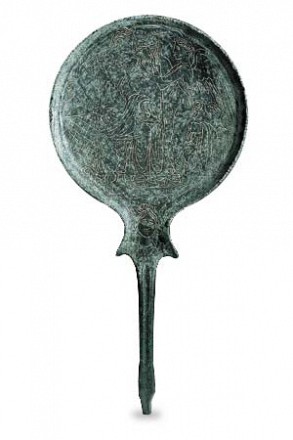
AG 1984.5.1- Mirror, Etruscan, Late Fourth Century B.C.
By Angela Gonzalez, Curatorial Intern
Etruscan civilization flourished in Italy from the ninth to the first century B.C. when the Etruscans were integrated into the Roman Empire. Little is known about their culture including their origin, and their language is only partially understood. However, the Etruscans served as the conduit of ideas and achievements for the rest of the Mediterranean and they influenced the development of Roman society. Most interesting are the contributions of the Etruscans that are normally associated as inventions of the Romans. These consist of the arch, the invention of concrete, Roman numerals and the toga.
Mirrors were considered luxury items and have only been located in tombs that contain women. The non-reflecting side, or reverse side, is often decorated with scenes from Etruscan mythology or illustrations of daily life. The Cummer mirror is one single cast piece. The imagery on the non-reflecting side shows a seated woman on the left surrounded by items related to her toilette. On the right is a bird delivering a necklace to the seated woman, while a winged figure stands before her. The woman has been identified as Malavisch, the Etruscan name for a figure associated with wedding rituals. Scenes of adornment are common on Etruscan mirrors, supporting the idea that these objects were given as wedding gifts.


